|
Ferrari Enzo
Debut: 2002
Maker: Ferrari
Predecessor: F50 |
|
Background
Whenever we
talk
about supercars,
Ferrari must be the word mentioned most frequently. Supercar era was
started
by Ferrari 288 GTO in 1984 and evaporated by F40 three years later. To
many people, F40 is still the best supercar Ferrari ever produced,
eclipsing
its successor F50 in many areas. Sadly, F50 is now generally regarded
as
one of the few failures of Maranello. Compare with its predecessor, it
was heavier and slower. Its naturally aspirated V12 produced far less
torque
than the older twin-turbo V8. Its barchetta architecture was nonsense
to
a 200mph supercar. Its soft roof blew off at high speed. Its vibration
and harshness caused by mounting the engine directly to carbon fiber
chassis
was terrible even by supercar standard. Worst of all, it was the
ugliest
supercar ever appeared, beside Lister Storm of course.
With
such a
backward development,
no wonder Ferrari lost its top spot in supercar chart. Admittedly, even
if F50 were not so bad, it would not have clinched the title either.
You
already know why: in 1993, McLaren launched the mighty F1 road car,
which
raised the game so high that, even after 9 years, no one else can touch
it.
McLaren F1 was
so
successful
because of 3 reasons. Firstly, it had the world’s most powerful engine
- 627hp BMW V12, and being naturally-aspirated it was free of any turbo
lag. Secondly, it was by far the lightest supercar, weighing just
1138kg.
No wonder it could reach 60mph in 3.2 seconds, 100mph in 6.3 seconds
and
200mph in 28 seconds. Thirdly, it had a low drag coefficient of 0.32
and
an unusually small frontal area, enabling it to set a speed record of
240mph.
Now, after 9
long
years,
Ferrari Enzo becomes the first challenger to McLaren F1.
Ferrari
Enzo -
the closest
challenger to McLaren F1
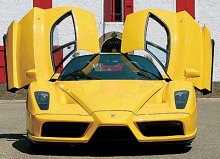 Whenever
a car is named after the founder of its maker, you know it must be very
serious. An example is my dream car Bugatti EB110, which named after
Ettore
Bugatti. But this one is even more serious, because it is named after
Enzo
Ferrari, the greatest name in Grand Prix history and sports car
industry. Whenever
a car is named after the founder of its maker, you know it must be very
serious. An example is my dream car Bugatti EB110, which named after
Ettore
Bugatti. But this one is even more serious, because it is named after
Enzo
Ferrari, the greatest name in Grand Prix history and sports car
industry.
In the
beginning
of project
FX, Ferrari set a target of beating McLaren F1 in acceleration, if not
top speed. Ferrari knew it is impossible to build a car faster than the
McLaren in terms of top speed (unless you have 1000 horsepower like
Bugatti
Veyron) because that require a very low drag coefficient, which
inevitably
sacrifice downforce, and a small frontal area, which needs narrow
tracks.
Both deteriorate handling. In fact, McLaren F1 was always regarded as
tricky
to handle, failing to put down its tremendous power effectively onto
ground.
Ferrari cannot tolerate that, because it prefers to measure performance
according to lap time in Fiorano, its home track.
To
out-accelerate
McLaren,
Ferrari developed an all-new V12 for Enzo. It displaces 5998cc, 66cc
smaller
than McLaren’s V12, but it produces 660 horsepower and 485 pound-feet
of
torque. In other words, 33hp and 6lbft more than its rival. This become
even more impressive if you consider the stringent emission regulation
compare with that 9 years ago. Besides, the Ferrari engine is
considerably
lighter - 225kg versus 266kg.
The Ferrari
also
has a superior
semi-automatic gearbox to enable faster yet easier shifting.
Furthermore,
it is equipped with "launch control" program to optimize launching. If
you remember, Ferrari used it in Formula One in the mid-90s until being
banned by FIA.
Nevertheless,
when the development
program entered its final phase, Maranello knew their hope of beating
McLaren
F1 in acceleration became slim as they failed to match the target
weight
of 1200kg. Why? because the Enzo is XL-size compare with McLaren F1,
being
40cm longer and 20cm wider. Also because of Ferrari boss Luca di
Montezemolo,
who insists even the most serious Ferrari must deliver a level of
comfort,
refinement and ease of driving. For example, Enzo has air-conditioning
as standard equipment. It also has adaptive damping (like F50), power
steering
and braking, ABS and traction control. McLaren had none of these.
Eventually,
the
production
Enzo tips the scale at 1365kg, some 227kg heavier than the F1.
According
to official figures, it tops "more than" 217mph (350kph) and
accelerates
from rest to 60mph in a little over 3.5 seconds, both are slower than
the
F1. Although Ferrari claims it beat McLaren to 200kph (124mph) by 0.1
second,
its worse power-to-weight ratio says otherwise. Sadly, Ferrari needs
that
moral victory - no matter how trivial - to get out of the shadow of
McLaren
F1.
Anyway, Enzo
is
already the
fastest car since McLaren F1. All other supercars - 911GT1, CLK-GTR and
Pagani Zonda included - are now eclipsed by Enzo.
Dramatic
Styling
 The
serious manner of Ferrari Enzo is immediately revealed by its exterior
styling. It looks striking, purposeful and uncompromising. Undoubtedly,
it is more beautiful than the F50, but compare with Pagani Zonda and
some
older Ferrari, say, 288 GTO and Testarossa, it is by no means a beauty.
Although it was also designed by Pininfarina studio, the responsible
designer,
Japanese Ken Okuyama, was not very famous in this field. No one knows
what
he designed during his years in GM and Porsche before joining
Pininfarina
as Assistant Director of Design. People only remember the Rossa concept
which starred in 2000 Turin motor show. In prior to the launch of Enzo,
Okuyama had already left Pininfarina and accepted a teaching post in a
design college. Therefore Enzo is his only Ferrari made into production. The
serious manner of Ferrari Enzo is immediately revealed by its exterior
styling. It looks striking, purposeful and uncompromising. Undoubtedly,
it is more beautiful than the F50, but compare with Pagani Zonda and
some
older Ferrari, say, 288 GTO and Testarossa, it is by no means a beauty.
Although it was also designed by Pininfarina studio, the responsible
designer,
Japanese Ken Okuyama, was not very famous in this field. No one knows
what
he designed during his years in GM and Porsche before joining
Pininfarina
as Assistant Director of Design. People only remember the Rossa concept
which starred in 2000 Turin motor show. In prior to the launch of Enzo,
Okuyama had already left Pininfarina and accepted a teaching post in a
design college. Therefore Enzo is his only Ferrari made into production.
Obviously,
Okuyama’s work
was not as magical as Leonardo Fioravanti. Compare Enzo with its big
grandmother
288GTO and you will see what I mean. Fioravanti’s GTO looks pure and
sexy;
Enzo looks untidy and dramatic; GTO conforms to one design language;
Enzo’s
racing-car nose is at odds with the show-car-like tail; GTO uses
grilles
to hide those big ventilation holes yet contribute to graphical beauty;
Enzo leaves all huge ventilation holes exposed, ruining the body
profile
and giving us a wind-blocking image.
Yes, the
design
philosophy
of Enzo is all about ventilation and downforce management. Look at that
ultra-long Formula 1 nose, it is not just for look but draws air
towards
the ground-effect diffusers to generate downforce. Look at all those
huge
air scoops at nose, at the leading edge of rear wings and those air
outlets
at either side of the triangular bonnet and at the trailing edge of
front
wings, the whole car is virtually covered by holes!
That said,
Ferrari Enzo was
shaped according to functions rather than art. Unfortunately, unlike
360
Modena, in this case functions are not compatible with beauty. What the
Enzo does impress its viewers is how striking and dramatic it looks,
especially
viewing from the front. No other cars have a nose so dramatic.
Beautiful
or not, you know this is the most serious performance machine ever
coming
out of Maranello.
Advanced
Aerodynamics
The Enzo has
an
aerodynamic
drag coefficient as poor as 0.36, virtually back to the Testarossa era.
However, like Formula 1 cars, its emphasis is on downforce and
therefore
handling. When you have 660 horsepower on tap and 217mph top speed, you
know how important downforce is.
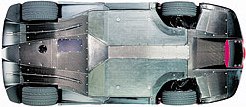 The
downforce generated by Enzo is unimaginable, especially for a car
having
no big rear spoiler. At 300kph (186mph), it generates a massive 775kg
of
downforce, compare with Pagani Zonda’s 500kg. Most of the downforce is
contributed by the ground effect diffusers at the bottom of the tail.
Many
other supercars also have similar stuffs, but Enzo’s is far more
powerful
because its high nose draws a lot of fast air flow towards the
diffusers.
Thanks to what they learned from Formula 1 racing. The
downforce generated by Enzo is unimaginable, especially for a car
having
no big rear spoiler. At 300kph (186mph), it generates a massive 775kg
of
downforce, compare with Pagani Zonda’s 500kg. Most of the downforce is
contributed by the ground effect diffusers at the bottom of the tail.
Many
other supercars also have similar stuffs, but Enzo’s is far more
powerful
because its high nose draws a lot of fast air flow towards the
diffusers.
Thanks to what they learned from Formula 1 racing.
A smaller part
of
the downforce
is contributed by a tiny rear spoiler and a pair of internal aero flaps
located in front of the front wheels. Both of them are automatically
adjustable
according to speed. For example, at 200kph (124mph), the Enzo generates
344kg of downforce. This rises to the maximum 775kg at 300kph (186mph),
and then eases back to enable higher top speed. At 217mph (350kph), the
downforce is reduced to 585kg.
Improved
Chassis
Unsurprisingly,
Enzo’s chassis
tub is constructed entirely in carbon-fiber to keep weight as low as
possible.
Bodywork is made of an even lighter material - aluminum honeycomb
sandwich.
Sandwiched by what? carbon fiber skins of course.
However, what
really distinguish
the Enzo from its predecessor F50 are: 1) the new car is a coupe rather
than a spider, with a fixed roof and a pair of "butterfly" doors. This
makes a lot more sense to such a serious supercar. 2) its engine and
gearbox
are mounted on an alloy sub-frame via rubber bushings rather than
bonded
directly to the carbon fiber tub. In this way noise and vibration are
isolated
from the cockpit.
So, the
chassis of
Enzo
is constructed in this way:
1)
Carbon-fiber
tub bonded
with roof.
2) Front
sub-frame
is attached
to the tub.
3)
Double-wishbones
front
suspensions are mounted on the sub-frame. The suspensions employ alloy
control arms and racing-style, horizontal push-rod type damper / spring
units. The dampers are adaptive type, controlled by computer.
4) Alloy rear
sub-frame
is attached to the tub.
5)
Rear suspensions
are
mounted directly on the sub-frame. Same specifications as the front
suspensions
mentioned above.
6)
Engine and
transmission
are mounted on the sub-frame via 3 rubber bushings.
7) The whole
structure is
clad with a bodywork made of aluminum honeycomb sandwich.
World-beating
V12 Engine
You know,
engine
is always
the strength and soul of Ferrari, but the V12 of Enzo is really the
best
of the best, while the same cannot be said to F50. If you remember, the
4.7-litre, 60-valve, F1-inspired V12 of F50 was once praised by the
world
for its ability to rev to 8500rpm and its super-high specific output of
110 horsepower per litre. However, it could not escape the automotive
law
of "there is no replacement for displacement", thus generating just 347
pound-foot of torque. No wonder F50 actually accelerated slower than
its
predecessor F40, which had 425lbft on tap.
Therefore,
Ferrari finally
followed the footprints of McLaren to seek power from a large-capacity
V12. This time they developed a 65° V12 displacing a full 6 litres
(5998cc). If you think larger capacity must reduce efficiency, you will
be wrong this time. The new V12 produces the same 110hp out of every
litre,
thanks to the introduction of variable valve timing. Previously,
Ferrari
applied VVT to 360 Modena only, and it was just a two-stage system
working
at exhaust camshafts. In contrast, Enzo employs continuously variable
valve
timing at all four camshafts. This is undoubtedly a big improvement to
Ferrari, although McLaren F1 already had Double Vanos some 9 years ago.
We have to
mention that the
new V12 switched back from 5-valve to conventional 4-valve per cylinder
like Ferrari's formula 1 engines since the mid-90s. This might give us
a clearer answer to our long-existing suspect: is 5-valve really better
than 4-valve?
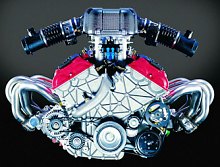 The
new V12 employs a variable-length intake manifold made of carbon fiber.
At below 3500rpm, induction length extends from 340mm to 430mm to
improve
low-speed torque. On the other hand, the increased capacity brings
485lbft
of maximum torque at 5500rpm, a massive 138lbft more than F50 yet it is
achieved at 1000rpm lower the rev. Mid-range torque is also good, if
not
class-leading, with 80% of peak torque available from 3000rpm. The
new V12 employs a variable-length intake manifold made of carbon fiber.
At below 3500rpm, induction length extends from 340mm to 430mm to
improve
low-speed torque. On the other hand, the increased capacity brings
485lbft
of maximum torque at 5500rpm, a massive 138lbft more than F50 yet it is
achieved at 1000rpm lower the rev. Mid-range torque is also good, if
not
class-leading, with 80% of peak torque available from 3000rpm.
However, the
beauty of this
V12 is how revvy and efficient it is without sacrificing tractability.
If you look at its oversquare combustion chamber (92mm bore x 75.2mm
stroke)
and 11.2:1 compression ratio, you will understand why it can rev higher
and therefore deliver more horsepower than the V12s from McLaren,
Lamborghini
and Pagani. The Ferrari engine redlines at 8000rpm and cut-out at
8200rpm.
In other words, it is the highest revving V12 in the world this side of
F50.
At
7800rpm, it
generates
660 horsepower, a record for any road-going engine. That’s an
astonishing
140hp more than F50, 105hp more than Pagani Zonda, 80hp more than
Lamborghini
Murcielago and 33hp more than the emission-unfriendly McLaren F1! and
don’t
forget the Ferrari V12 displaces less cc than all of them.
At 225kg, the
6-litre V12
is 27kg heavier than F50’s 4.7-litre unit. However, it is still lighter
than its rivals and virtually matches Mercedes 5.8-litre sohc V12,
which
is currently the lightest V12 in the world. I can’t help praising
Maranello’s
engineers. Perhaps this is what they learned from formula 1.
F1 Gearbox
and
Control
System
Enzo
integrates
the control
systems of engine, gearbox, damping, aerodynamic aids, ABS, EBD brake
force
distribution and ASR traction control so that they work in harmony with
each other. This also allow a race mode - when the driver push the
"Race"
button on steering wheel, computer will firm up the adaptive damping,
select
the middle setting of traction control (which allows a fair degree of
slide)
and quicken the gearchange of the F1 semi-automatic gearbox.
People
used to
have reservation
about Ferrari’s F1 gearbox because of its violent shift quality and
sometimes
inconsistent response. Anyway, for an uncompromising supercar like
Enzo,
F1 gearbox is perhaps more suitable than conventional manual. Think
about
it: this car takes just 3.5 seconds to reach 60mph and 9.5 seconds to
124mph,
everything happens so quickly that you don’t have time to respond, so a
fuss-free semi-automatic with steering column mounted paddles will keep
you free of nervous and let you concentrate on the road. Moreover, the
F1 gearbox shifts quicker than human hands. At race mode, it can shift
within as little as 150ms, same as the system used by 360M and 70ms
faster
than 575M’s. Shift quality will inevitably suffer, but note that Enzo
is
not bought for refinement.
Ceramic
Brakes
Ferrari
follows
Mercedes
and Porsche to introduce ceramic brakes. They are supplied by Brembo,
Ferrari’s
partner in formula 1. The discs are huge in size (380mm diameter all
round)
and are clamped by monobloc alloy calipers with 6 pistons front and 4
pistons
rear. However, the most special is the material of the disc - Brembo
calls
it CCM (Ceramic-Composite Material). Strangely, Ferrari gives another
explanation
to CCM - Carbon-Ceramic Material - to link with its formula 1
carbon-composite
discs. In fact, many magazines were fooled and simply refer them as
carbon-fiber
brakes.
There is a
significant difference
between a real carbon-composite brakes used in formula 1 and the
ceramic-composite
brakes used in Enzo: the former needs 200-300degC to work properly,
otherwise
it will be powerless. In contrast, CCM works at normal temperature. It
is also much cheaper to build, though not as light. However, 4 pieces
of
ceramic brakes still save Enzo a valuable 12.5kg compare with
conventional
steel brakes. Moreover, they have the advantage of long life and heat
resistance
thus free of fade.
On the Road
Supercars must
have super
doors, isn’t it? sounds a bit nonsense, but the way the doors open has
a decisive influence to millionaires or billionaires who buy supercars,
for they buy mainly for sense of occasion. They won’t be disappointed
with
Enzo, as the car have a pair of butterfly doors swinging upward and
forward
in McLaren F1 style. Better still is how easy to get into the cockpit,
as the doors open also a large portion of the roof (Enzo’s roof is
actually
a T-bar) thus you need not to mind your head. You don’t need to step
across
a wide sill either, unlike what you did in other supercars, because the
doors cut into the sills. Now you notice that Enzo’s carbon-fiber tub
does
not run the full width of the car. The doors are mounted outside the
tub
rather than onto the tub.
 Once
you get into the cockpit, you’ll notice this is a "cab-forward" design.
Thanks to the lack of transmission tunnel, the seats locate close to
the
center of the car thus Ferrari can push them forward without being
blocked
by front wheels. As a result, pedals are less offset than Lamborghini. Once
you get into the cockpit, you’ll notice this is a "cab-forward" design.
Thanks to the lack of transmission tunnel, the seats locate close to
the
center of the car thus Ferrari can push them forward without being
blocked
by front wheels. As a result, pedals are less offset than Lamborghini.
Wrapping you
tightly is a
red racing bucket tailor to your size (customers are invited to
Maranello
to test the right seats and tailor the positions of pedals).
Surrounding
you is an all-carbon-fiber environment. Not only the bare tub is
carbon-fiber,
but the instrument panel, center console, the whole dashboard
architecture
and even part of the steering wheel! some might think cool, but I would
prefer more leather and alloy for the color and graceful feel they
deliver.
Disappointingly, the carbon-fiber panels are not tightly fit while the
design of the whole interior is ugly, more like a video game machine.
Pagani
Zonda looks more expensive in this respect.
Twist the
key...
excuse me,
press the "Start" button, the super V12 immediately impresses you by
its
smoothness. It is unusually creamy for a sporting V12, so smooth that
at
idle it may fool you as a limousine engine. It is also very tractable,
pulling happily at top gear at 40mph. Prod the throttle, exhaust note
gets
more serious, and becomes even more exciting once the second stage of
variable
exhaust (to pass noise regulation) cut in. The short-stroke V12 still
spins
freely, smoothly all the way to 8200rpm. It is really a masterpiece!
 Acceleration
is of course astonishing. Although we are unlikely to obtain any tested
performance figures - Ferrari refuses to offer Enzo to any journalists
for performance testing - undoubtedly, the Enzo gains speed so quickly
that no existing supercars can trail it. Think about it: Ferrari said
the
car complete a lap of Fiorano in 1min 25sec, a massive 5 seconds
quicker
than F50! Acceleration
is of course astonishing. Although we are unlikely to obtain any tested
performance figures - Ferrari refuses to offer Enzo to any journalists
for performance testing - undoubtedly, the Enzo gains speed so quickly
that no existing supercars can trail it. Think about it: Ferrari said
the
car complete a lap of Fiorano in 1min 25sec, a massive 5 seconds
quicker
than F50!
But one thing
makes Enzo
so special: while it is super-fast, it remains so calm, so
well-controlled
and so easily accessible. While it is accelerating, all you feel is the
g-force which press your head hardly onto the headrest. There is no
dramatic
nose-lift or wheelspin. The car has a lot of traction and ASR always
ensure
engine power not to overwhelm the chassis.
The
chassis is so
stable
in corner, with nearly zero roll. It also controls its tremendous power
very well. There is strong grip from the tyres and downforce to keep
the
car firmly on road. At its best, the car can corner at an astonishing
1.36g.
If you enter a corner too quickly, Enzo will understeer gently. It can
get into oversteer under throttle, but to power slide it seems very
difficult
- and better to be avoided - because you have to turn off the ASR and
fight
against the tremendous power by your own "human traction control".
The
steering at
2.2 turns
from lock to lock is quick, accurate and feelsome. Though being power
assisted,
weighting is heavy - a good thing to such a serious supercar. The
semi-automatic
gearbox works well on track (but I don’t expect it to perform as
consistent
on public road), reasonably smooth and very responsive. Because the
Enzo
accelerates so quick, the clutchless paddle-shift gearbox relieves
pressure
from the driver and let him concentrate on steering, throttle and
braking,
thus is a valuable equipment.
The ceramic
braking is perhaps
the best single element of the car. It is simply the most powerful
braking
system ever appear on road cars. I guess maybe half of the 5-second cut
over F50 is purely due to the new brakes.
On
Fiorano,
Enzo’s variable
damping works well. In the most comfortable setting it even damps more
beautifully than 575M. Anyway, like all other handling aspects of the
car,
we have to wait for a road test on a proper public road to give the
final
verdict. Many Ferrari used to rate high in Fiorano, because they were
extensively
tested and tuned there. Whether Enzo’s outstanding ability translate to
public road is yet to be seen.
However, we
can
already conclude
that Enzo is a more complete supercar than McLaren F1, for its superior
chassis and accessibility. But the F1 remains to be the more desirable
one in my mind, for its performance, look and innovation. And that was
achieved in 1993.
Weight
of Enzo
Many magazines
confuse the weight
figures of Enzo and rivals. Ferrari claims Enzo's dry weight is 1255kg
while kerb weight (with driver, engine fluid and half tank of fuel) is
1365kg. In the past, Ferrari quoted only dry weight for F40 (1100kg)
and
F50 (1230kg). Many other Italian supercar specialists also prefer to
quote
dry weight, such as Pagani Zonda C12S (1250kg) and Lamborghini
Murcielago
(1650kg).
Unfortunately,
some magazines
(including Autocar and Evo) confused dry weight with kerb weight thus
incorrectly
reported that Enzo were 135kg heavier than F50 or 115kg heavier than
Pagani
Zonda etc. In fact, Enzo is just 25kg heavier than F50 and 5kg heavier
than Zonda.
However,
McLaren
F1's 1138kg,
according to McLaren, is kerb weight. Therefore it is 227kg lighter
than
Enzo.
Price
and
production number
In two year’s time,
Ferrari
will build a limited run of 349 units of Enzo, the same as F50. Each
sold
at around £450,000, just slightly cheaper than McLaren F1. That
can
buy 2 Pagani Zondas or 3 Lamborghini Murcielago. |
| The
above report was last updated on 25 Sep
2002. All Rights Reserved. |
Enzo performance recorded
|
In April
2003,
Ferrari invited
several big magazines to measure the performance of Enzo at Fiorano.
Strictly
speaking, this is not a fair testing, because: 1) the Enzo was driven
by
Ferrari’s test driver; 2) the short straight in the Fiorano track they
used to record acceleration is a slightly downhill slope. Poor Ferrari
did all the dirty tricks in an attempt to match McLaren F1’s figures
recorded
a decade ago by Autocar.
Even
so, it
failed. Autocar
timed the Enzo doing 0-60mph in 3.5 sec (McLaren: 3.2) and 0-100mph in
6.6 sec (McLaren: 6.3), which just confirmed my prediction beforehand -
Enzo is the fastest supercar today, but slower than the mighty McLaren
F1. The short straight at Fiorano meant acceleration at above 120mph is
not possible, so we have no chance to see how McLaren extend its margin
over Enzo at 200mph, which it did in just 28 seconds.
Don’t take
these
figures
seriously, however. No one knows how much slower the Enzo will be if
Ferrari
let magazines do the job properly - at a horizontal surface, on a stock
Enzo and by a third-party test driver. |
| The
above report was last updated on 15 May
2003. All Rights Reserved. |
A fair performance test by R&T, finally.
|
The wait
is over.
Ferrari Enzo
is finally tested in a fair condition by a third party. In the July
2003
issue of R&T, the magazine borrowed an Enzo from owner Richard
Losee,
travelling for 1000 miles to the Bonneville Salt Flats of Utah to see
its
real-world performance and then back to California for performance
recording
in a proving ground. In the end, they recorded the following figures:
0-60
mph: 3.3 sec
0-100
mph: 6.6 sec
1/4
mile: 11.1 sec @ 133.0mph
Base on these
figures, R&T
declared that the Enzo is faster than McLaren F1 ! it said the F1 they
tested a few years ago did 0-60 in 3.4 sec and 1/4 mile in 11.6 sec
@125mph.
However, it did not mention that that particular F1 was not a standard
European version, as it was converted by the owner to meet the US
regulations.
If we take Autocar’s test data for the standard car, you will see the
F1
was faster still:
0-60
mph: 3.2 sec
0-100
mph: 6.3 sec
1/4
mile: 11.1 sec @ 138mph
From the time
of
0-100mph
and the terminal speed of 1/4 mile, you can easily see the higher the
speed,
the faster the McLaren is compared with Enzo.
That’s not
surprising to
me. Remember, the Enzo is more than 200 kilograms heavier than the F1.
Sophisticated launch control of the 21st century may help it to reduce
tyre slippage at launch thus match the F1 for the first quarter mile,
but
once the F1 get rolling, the rate it accelerate will be much higher
than
the Ferrari. The point is, at this level of competition, there is no
miracle
can negate the deficit in power-to-weight ratio, which favours the
McLaren
overwhelmingly. At higher speed, another scientific parameter - drag
coefficient
and frontal area - says the Enzo can only lose more. The McLaren can
reach
200mph in 28 seconds dead. I would be very surprised if Ferrari Enzo
can
do that within 30 sec. Believe me. |
| The
above report was last updated on 5 July
2003. All Rights Reserved. |
More impression and verdict
|
Evo
magazine tested
the Enzo
on public road and gave us a few more hints about its road manner. Its
ride is surprisingly compliant. At low speed, the steering is not very
feelsome, especially at initial turn-in. In comparison, Pagani Zonda
has
a more communicative and confidence-inspiring steering setup. However,
the weight and feel of the Enzo's steering improves gradually as speed
and downforce increases. Above 60mph, it is no longer a problem and you
can fully trust the chassis.
Evo
confirmed our
saying
that the Ferrari supercar is extremely easy to go faster than aware,
because
its handling is obedient, its acceleration and deceleration are both
mighty
quick. Later, R&T magazine drove the Enzo for 1,000 miles and
concluded
"The Ferrari Enzo is both an ultra-high-performance car and a capable
grand
tourer."
Finally, we
have
to make
a decision to the question we left over: is Enzo the best supercar
currently
on offer?
In
objective
terms, yes,
because it goes much faster than its sole rival Pagani Zonda yet
without
the uncompromising handling / ride manner of traditional supercars.
However,
in subjective terms it can't beat the Zonda, which is equally
user-friendly
on road while subjectively hardly feel any slower or less exciting. In
particular, the AMG V12 makes a wonder noise, beating Ferrari's V12 in
sound quality.
Then,
you can't
help amazed
how the Zonda's strengths hit right at the Enzo's weaknesses - one
looks
tastefully styled and elegantly finished, built with the highest
quality
ever seen in supercar business, while another looks strange and built
like
a cheap kit car. Just look at the varying assembly gaps of the exterior
body panels and the ill-fitted carbon-fiber parts in the cockpit and
you
will see the Enzo will never be a perfect masterpiece to car
collectors.
Therefore, while my brain says the Enzo is the winner, my heart chooses
the Zonda.
However, in
half
a year's
time both will face tougher competition from Porsche Carrera GT,
McLaren
Mercedes SLR and Bugatti Veyron. Watch this space then. |
| The
above report was last updated on 17 Jun
2003. All Rights Reserved. |
218.7 mph - Enzo beats rivals in Nardo
|
In 1998,
McLaren F1
set a record
of 240.1mph at Nardo, Italy, the fastest proving ground in the world.
Since
then no other cars ever came close. A prototype Koenigsegg CC8S was
said
to reached 233mph there, but no one really know if the car was finished
like the final production car and complied with all legal regulations.
In June 2004, German magazine Auto, Motor und Sport took 6 of the
current
generation fastest supercars to Nardo for top speed measurement, hoping
to find out which one is currently the fastest car in the world.
Unfortunately,
they did not get the Koenigsegg, so the contenders are limited to
Ferrari
Enzo, Porsche Carrera GT, Mercedes SLR and Lamborghini Murcielago, plus
a couple of also-runner, Aston Martin DB9 and Bentley Continental GT.
In the end of
the
day, they
confirmed my believe - Ferrari Enzo recorded 218.7mph, some 13mph
fastest
than either Carrera GT and SLR. Moreover, it also beats other cars in
any
of the acceleration figures. Enzo is finally confirmed as the world's
fastest
car of this generation !
|
Model
|
Top
speed
|
0-60
mph
|
1/4
mile
|
1
mile
|
|
Ferrari
Enzo
|
218.7
mph
|
3.6
sec
|
11.4
sec
|
20.1
sec
|
|
Porsche
Carrera GT
|
205.8
mph
|
3.8
sec
|
11.5
sec
|
20.4
sec
|
|
Mercedes
SLR McLaren
|
205.8
mph
|
3.8
sec
|
11.5
sec
|
20.5
sec
|
|
Lamborghini
Murcielago
|
203.3
mph
|
3.7
sec
|
11.8
sec
|
21.4
sec
|
|
Bentley
Continental
GT
|
198.4
mph
|
5.2
sec
|
13.4
sec
|
23.9
sec
|
|
Aston
Martin DB9
|
190.4
mph
|
5.0
sec
|
13.1
sec
|
23.6
sec
|
Surprisingly,
All
these
cars ran very close to their claimed top speed, including the
traditionally
optimistic Ferrari.
Another
thing to
note is
how these cars behave at top end - the Ferrari was found to be the most
stable, thanks to its superior variable aerodynamics which enhances
downforce
at high speed and varies to maintain the balance between front and rear
downforce. It seems that F1 experience really helped the Enzo. Carrera
GT is also pretty stable at high speed, if not matching the Ferrari, in
contrast to SLR which vibrates severely.
Apart from
Koenigsegg, the
test also didn't include Ford GT. Earlier this year Ford itself
recorded
205mph at Nardo. |
| The
above report was last updated on 14 Aug
2004. All Rights Reserved. |
Ferrari FXX
|
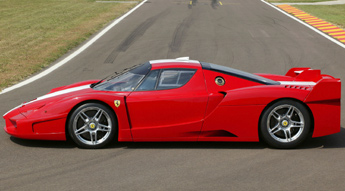 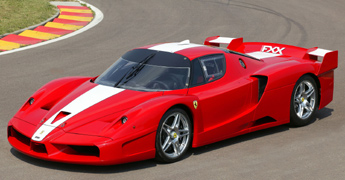
Ferrari promised that only 349 units of Enzo would be built. But then
it started playing tricks. Initially, it modified the Enzo into
Maserati MC12 and sold 55 cars. Then it upgraded the Enzo into an even
hotter track-oriented machine and sold 29 such cars, plus another one
given to Michael Schumacher as his retirement present. This car is
officially called FXX, but if you call it Enzo R you won't be far off.
The FXX has enhanced spoilers and aero kits to help increasing 40%
downforce over the already remarkable Enzo. At the same time, its V12
is enlarged to 6262 cc, accompany with racing grade tuning it pumps out
over 800 horsepower at 8500rpm ! some 140 more than Enzo. Besides, the
shift time of the F1 gearbox is shortened from 150ms to race car-like
100ms. The car rides on specially developed Bridgestone slick tires.
The Brembo carbon ceramic brakes are enhanced with bigger discs and a
special cooling and pad system.
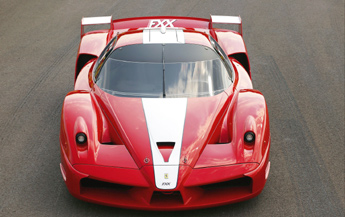 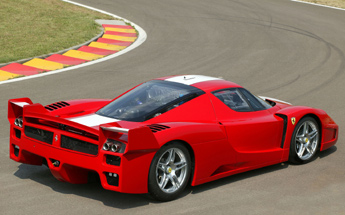
Although FXX is not destined to international racing, it is purely
designed for racing tracks. Ferrari did not try to homologate it for
road use, thus it is not road legal in most countries. So, what is the
purpose of building it? In fact, Ferrari sold it as a "track days car"
to those rich people who love racing their supercars. Each FXX is
priced at an astonishing 1.5 million Euro, but that include a complete
test program and driving course. At first, the buyers were invited to a
driving course at Ferrari's Fiorano track where their cars are normally
stored. Then they can arrange for driving their cars at private test
sessions. Ferrari also arranged a series of track events in various
international-level circuits for FXX to race. The cars would be shipped
to those circuits and then ship back to Maranello. Each driver would be
instructed by Ferrari's racing drivers (including Michael Schumacher).
The on-board telemetry system transmits data to Ferrari's technicians,
who analyse their driving skills and car setup and discuss with the
drivers.
That seems to be a great idea for earning more money. |
| The
above report was last updated on 24 Aug
2007. All Rights Reserved. |
Maserati MC12 - derivative of Enzo
|
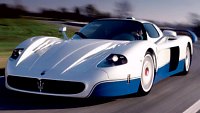 Though
badged as Maserati, MC12 is actually a derivative of Ferrari Enzo. More
accurately speaking, it is the racing version of Enzo, designed to race
FIA GT championship. This is implied by the name MC, which stands for
Maserati
Corsa, or Maserati Competition, while 12 is the cylinder count.
Predictably,
the car is hand-built by Ferrari technicians and the racing program is
run by Schumacher's boss, Jean Todt. Anyway, today you can no longer
separate
Ferrari and Maserati. Their design, engineering and production are
integrated
together. Though
badged as Maserati, MC12 is actually a derivative of Ferrari Enzo. More
accurately speaking, it is the racing version of Enzo, designed to race
FIA GT championship. This is implied by the name MC, which stands for
Maserati
Corsa, or Maserati Competition, while 12 is the cylinder count.
Predictably,
the car is hand-built by Ferrari technicians and the racing program is
run by Schumacher's boss, Jean Todt. Anyway, today you can no longer
separate
Ferrari and Maserati. Their design, engineering and production are
integrated
together.
The
styling of
MC12 was said
to be originated by Giugiaro and executed by Frank Stephenson, but
apart
from the grille we cannot see anything like a Maserati. In fact, MC12
is
very close to Enzo in appearance. It is virtually an Enzo with
aerodynamic
kits enhanced for racing tracks. Its carbon-fiber bodywork is a massive
440mm longer and 60mm wider than the already big Enzo, taking the
overall
length to an astonishing 5.14 meters and overall wdith to 2.1 meters.
The
wheelbase is also stretched from 2650mm to 2800mm to enhance stability.
To observers, the most spectacular is the super-long front and rear
overhangs,
which are necessary to create the tremendous downforce it requires. In
particular, the long long tail incorporates huge diffusers to generate
ground effect. But that's not enough, Maserati - well, Ferrari - added
a huge fixed rear spoiler to generate even more downforce. No figures
are
available, but undoubtedly it will shame Enzo's tiny electric rear
spoiler.
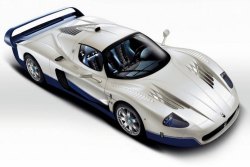 The
cockpit also differs from Enzo a little bit. First of all, you will
find
its doors are conventionally hinged, while the roof is targa. Above the
roof is a scoop ramming air into the V12. Once enter the cockpit, you
will
see the same basic architecture as the Enzo, even the same steering
wheel.
The same paddles control the same F1 semi-automatic transmission -
sorry,
now calls Cambiocorsa in Maserati’s language. Unlike other Maseratis,
there
is no luxurious equipment to talk about - no Hi-Fi, no radio, not even
a luggage compartment. This is a road-legal racing car ! The
cockpit also differs from Enzo a little bit. First of all, you will
find
its doors are conventionally hinged, while the roof is targa. Above the
roof is a scoop ramming air into the V12. Once enter the cockpit, you
will
see the same basic architecture as the Enzo, even the same steering
wheel.
The same paddles control the same F1 semi-automatic transmission -
sorry,
now calls Cambiocorsa in Maserati’s language. Unlike other Maseratis,
there
is no luxurious equipment to talk about - no Hi-Fi, no radio, not even
a luggage compartment. This is a road-legal racing car !
But Ferrari
fans
must be
anxious that it could be faster than the Enzo. Luckily, it is not. The
MC12 has its 6-litre V12 detuned from the Enzo’s 660hp / 7800rpm to a
still
appealing 630hp / 7500rpm. On the other hand, it is 80kg heavier than
the
Enzo, thanks to its extra bodywork and the use of steel brakes (FIA
ruled
out ceramic brakes). The latter alone costs 12.5 kg.
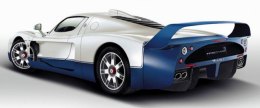 The
MC12 is claimed to top more than 205 mph and accelerate from 0-100km/h
in 3.8 sec, 200km/h at 9.9 sec, 1km at 20.1 sec. That leaves a slight
but
psychologically important victory to the Ferrari cousin, which claims
217mph+,
3.65 sec, 9.5 sec and 19.6 sec respectively. The
MC12 is claimed to top more than 205 mph and accelerate from 0-100km/h
in 3.8 sec, 200km/h at 9.9 sec, 1km at 20.1 sec. That leaves a slight
but
psychologically important victory to the Ferrari cousin, which claims
217mph+,
3.65 sec, 9.5 sec and 19.6 sec respectively.
By
the
time of
writing, around
30 MC12s have been built. 5 of them are race cars and 25 are road cars
to satisfy the homologation requirement of FIA GT championship. In
2005,
another 25 road cars will be built to satisfy the demand from those not
lucky enough to get one of the 349 Enzos. |
| The
above report was last updated on 4 Feb 2005. All
Rights Reserved. |
Maserati MC12 Corsa
|
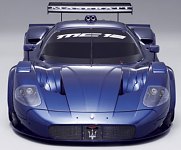 You can see this
car as the Maserati
version of Ferrari FXX. It is neither road legal nor road suitable (see
its non-existent ground clearance). It is not homologated to FIA's
regulations, so it could not participate any international racing.
However, Maranello will organize 6 races in Europe specially for the
owners of this car. Each customer pays 1 million Euro for the car -
equalling Bugatti Veyron - plus 260,000 Euro for the race package
(entry fees, fuel, tires and servicing). Only 12 cars were built. You can see this
car as the Maserati
version of Ferrari FXX. It is neither road legal nor road suitable (see
its non-existent ground clearance). It is not homologated to FIA's
regulations, so it could not participate any international racing.
However, Maranello will organize 6 races in Europe specially for the
owners of this car. Each customer pays 1 million Euro for the car -
equalling Bugatti Veyron - plus 260,000 Euro for the race package
(entry fees, fuel, tires and servicing). Only 12 cars were built.
 The Corsa is derived from the MC12 GT1 race car, but it has
2 seats, a 6-speed Cambiocorsa (F1) gearbox and a V12 without air
restricter. The latter raises its output to 757 horsepower, some 127 hp
more than the "regular" MC12 but 43 hp less than FXX. However, with a
dry weight only 1150 kg, the MC12 Corsa achieves an astonishing power
to weight ratio. The Corsa is derived from the MC12 GT1 race car, but it has
2 seats, a 6-speed Cambiocorsa (F1) gearbox and a V12 without air
restricter. The latter raises its output to 757 horsepower, some 127 hp
more than the "regular" MC12 but 43 hp less than FXX. However, with a
dry weight only 1150 kg, the MC12 Corsa achieves an astonishing power
to weight ratio.
|
| The
above report was last updated on 24 Aug
2007. All Rights Reserved. |
|
|